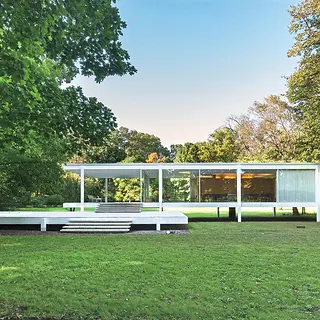
Visit Farnsworth House
Plan Your VisitReviews
The Edith Farnsworth House was designed and built between 1946 and 1951 as a weekend retreat for prominent Chicago nephrologist, musician, and poet, Dr. Edith Farnsworth, as a place to relax, entertain, and enjoy nature.
It is recognized as an iconic masterpiece of the International Style of architecture and has National Historic Landmark status. The architect was Ludwig Mies van der Rohe, and this was his first and most significant domestic project in America. Located 58 miles southwest of Chicago, the glass and steel house is set within a natural landscape on a 62-acre parcel located along the Fox River.
The significance of the Edith Farnsworth House was recognized even before it was built. In 1947, a model of the Edith Farnsworth House was exhibited at the Museum of Modern Art in New York. Describing it, Philip Johnson (the show’s curator, whose own Glass House was inspired by early drawings for this house) noted that “Farnsworth house, with its continuous glass walls, is an [even] simple[r] interpretation of an idea. Here, the purity of the cage is undisturbed. Neither the steel columns from which it is suspended, nor the independent floating terrace break the taut skin.”
In the actual construction, the aesthetic idea was progressively refined and developed through the choices of materials, colors, and details. While the livability of its design proved to be less than ideal, and the cost overruns were substantial, the Edith Farnsworth House would increasingly be considered by architects and scholars alike to constitute one of the crystallizing and pivotal moments of Mies van der Rohe’s long artistic career.
Designed by Mies van der Rohe in 1945 and constructed in 1951, the Farnsworth House is a vital part of American iconography, an exemplary representation of both the International Style of architecture as well as the modern movement’s desire to juxtapose the sleek, streamline design of Modern structure with the organic environment of the surrounding nature.
“Architecture starts when you carefully put two bricks together. There it begins.”
Mies van der Rohe
Mies constructed this glass box residence of “almost nothing” for Dr. Edith Farnsworth as a country retreat along the Fox River in Plano, IL. It continued to be a private residence for over 50 years until Landmarks Illinois and the National Trust for Historic Preservation purchased it in 2003.
Today it is owned and managed by the Trust and the site is open as a public museum.

photo by: John Doe
Its interior and furnishings were all designed to provide a sense of connection to the landscape outside.

Farnsworth House is an icon of modernist architecture.

The house was designed to be a serene island, a place of quiet reflection.
The significance of the Farnsworth House was recognized even before it was built. In 1947 a model of the Farnsworth House was exhibited at the Museum of Modern Art in New York. Describing it, along with the unbuilt Resor House, as a “radical departure from his last European domestic projects,” Philip Johnson noted that it went further than the Resor house in its expression of the floating volume: “The Farnsworth house with its continuous glass walls is an even simpler interpretation of an idea. Here the purity of the cage is undisturbed. Neither the steel columns from which it is suspended nor the independent floating terrace break the taut skin.”
In the actual construction, the aesthetic idea was progressively refined and developed through the choices of materials, colors and details. While subsequent debates and lawsuits sometimes questioned the practicality and livability of its design, the Farnsworth House would increasingly be considered, by architects and scholars alike, to constitute one of the crystallizing and pivotal moments of Mies van der Rohe’s long artistic career.
Benefits for National Trust Members
50% Off Regular Public Tours
Join the National Trust to enjoy a host of membership benefits.
Join TodayStay connected with us via email. Sign up today.
Related Stories
-
National Treasures Department of the Interior: Pop Culture’s Secret Weapon
Explore More Places
Become a member of the Trust and help us to preserve America's National Treasures
Join Today



